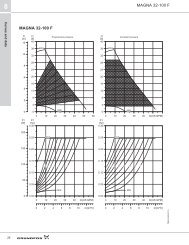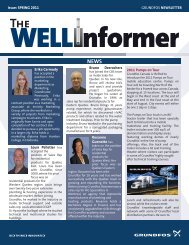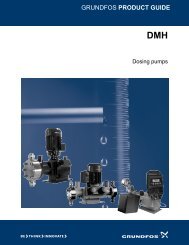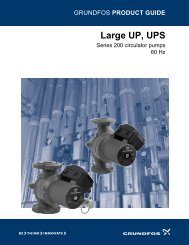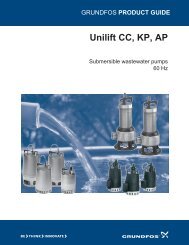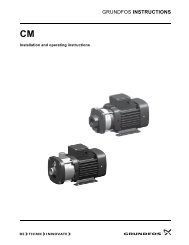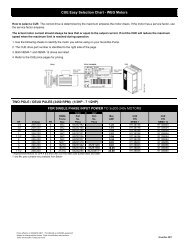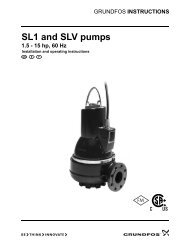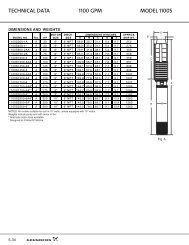You also want an ePaper? Increase the reach of your titles
YUMPU automatically turns print PDFs into web optimized ePapers that Google loves.
<strong>Grundfos</strong> E-<strong>pumps</strong><br />
10<br />
Pump operating at power limit<br />
When a pump in operation is running at maximum<br />
output power (P2) in the entire performance range<br />
from closed valve to maximum flow, it is said to be<br />
operating at power limit.<br />
H<br />
Extended operating range as a<br />
result of this function<br />
Power curve of a standard<br />
E-pump<br />
Power curve for an E-pump<br />
operating at power limit<br />
Fig. 86 Power curves of a standard pump and a pump<br />
operating at power limit<br />
Purpose and benefits<br />
This function utilizes the fact that often a standard<br />
E-pump does not load the MLE motor fully in the entire<br />
operating range. By controlling the MLE motor to<br />
always put out maximum power, irrespective of the<br />
load, it is now possible to extend the performance<br />
range of the pump without overloading the MLE motor.<br />
See fig. 86.<br />
In practice, this function provides these benefits:<br />
• The pressure range of the pump can be increased<br />
at low flows without using a bigger motor, provided<br />
that the pump construction can handle the pressure.<br />
• In some cases, the pump can be fitted with a<br />
smaller motor than the corresponding standard<br />
pump when the E-pump has a fixed operating range<br />
at low flows.<br />
This function is available in these pump sizes:<br />
Q<br />
TM03 9187 3507<br />
Applications<br />
This function is most often used in applications with<br />
relatively low flow in relation to rated performance<br />
where at the same time the demanded maximum pressure<br />
corresponds to the maximum pressure that motor<br />
and pump can achieve.<br />
Examples of application:<br />
• washing and cleaning<br />
• irrigation<br />
• boiler feed.<br />
Description<br />
As mentioned in section Purpose and benefits, there<br />
are two primary fields of application for this function:<br />
Increased pressure<br />
Figure 87 illustrates the operating range of a standard<br />
60 Hz E-pump with increased pressure range achieved<br />
by using the "pump operating at power limit" function.<br />
Performance<br />
curve for<br />
the standard<br />
E-pump<br />
H<br />
f<br />
Output frequency<br />
for the standard<br />
E-pump<br />
Maximum performance<br />
when operating at power<br />
limit<br />
Maximum power curve<br />
when operating at power<br />
limit<br />
Power curve for the<br />
standard E-pump<br />
Q<br />
Output frequency<br />
when operating at<br />
power limit<br />
Load<br />
TM05 3248 1012<br />
Advanced use of MLE motors<br />
2-pole<br />
[Hp]<br />
Single-phase <strong>pumps</strong><br />
4-pole<br />
[Hp]<br />
0.50 - 1.5 0.33 - 1.0<br />
- -<br />
Three-phase <strong>pumps</strong><br />
2-pole<br />
[Hp]<br />
1.0 - 10 15 - 30<br />
●<br />
●<br />
Fig. 87 Standard performance curve vs a performance<br />
curve with the "pump operating at power limit"<br />
function<br />
The MLE motor is set to a higher speed (f max ) than the<br />
rated speed of the pump. This leads to a higher pressure<br />
at closed valve and low flow.<br />
The pump will operate at a speed corresponding to the<br />
set frequency (f max ) until the pump reaches the flow<br />
where the motor is loaded to its full rated power. If the<br />
flow is increased further, the motor will reduce its<br />
speed so as not to exceed its rated power.<br />
Note: The pump will be running at oversynchronous<br />
speed in the low-flow area which may alter the sound<br />
level.<br />
73



